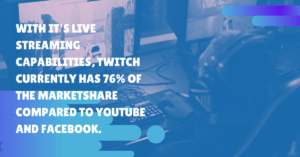The power of the influencer isn’t solely based on their ability to build consumer loyalty. Influencers have a positive impact on your ROI, and you can track that impact to measure your partnership’s success. Break down the different ways influencers bring attention to your business, and you’ll find that your ROI benefits through more avenues than you’d expect.
ROI Through Visibility
To pair visibility and its influencer marketing ROI, you’ll need to know ahead of time what your campaign is aiming for. Are you thrusting a new brand into the limelight? Or are you highlighting a new product? Depending on which, you’ll need to target your impressions to different audiences.
That means that when you utilize influencers, you’ll want to partner with someone whose audience matches yours. For example, when D&D Beyond wanted to reach new audiences about its Dungeons and Dragons app (yes, it’s niche), they reached out to a team of professional Dungeons and Dragons players. The audiences had significant overlap, and as a result, the company could draw in an audience that was already operating in its industry sphere.
ROI Through Engagement, or Cost-Per-Engagement
Cost-per-engagement reflects the dollar amounts businesses can attribute to each “like,” comment, re-pin on Pinterest, views, or click-through of an article that your influencers draw in. When a post generates significant CPE, then the product you’re advertising – and the work that your influencer is doing – draws in influencer marketing ROI.
You’ll be able to measure the sales that correlate with the campaign and compare them against the engagement that your influencer’s post received. A resulting positive number – even if it’s as low as $0.01 – indicates that your influencer is not only generating money for you, but they’re saving you money on your marketing campaign.
For example, consider Mountain Dew and Dorito’s paired commercial at the 2018 Super Bowl. With dozens of reposts on YouTube and the stunning star power of Morgan Freeman and Peter Dinklage, you can bet that both brands – collaborating, even as they seem to be pitching a brand war – capitalized on their CPE. When you bring on an influencer of less celebrity standing but equal influence, your own bottom line will be thanking you.
ROI Through Content
 Speaking of that difference: the content you create – and the costs that come along with it – are going to be less expensive to handle when you don’t have to negotiate copyright law. That is to say, you’re less likely to have to negotiate with an Instagram influencer over her image rights than you are with the aforementioned Morgan Freeman. If you work with an aesthetically-oriented influencer, you may not even have to pay out too heavily for a photoshoot.
Speaking of that difference: the content you create – and the costs that come along with it – are going to be less expensive to handle when you don’t have to negotiate copyright law. That is to say, you’re less likely to have to negotiate with an Instagram influencer over her image rights than you are with the aforementioned Morgan Freeman. If you work with an aesthetically-oriented influencer, you may not even have to pay out too heavily for a photoshoot.
Pair negotiable images with the kind of trust an influencer builds among her audience, and your ROI will be looking fairly sound.
For example, while WWE’s Xavier Woods career used to be in wrestling, he appeared in Dell’s bid to win over gamer audiences as a “gamer grandpa.” While he’s not an Instagram star, working with Woods’ was a good move for Dell’s ROI. Not only did his previous content bring a new audience to their computers, but revamping his image several years outside of the wrestling ring saved them money in the long-run.
ROI Through Revenue
If you’re less interested in social currency and more concerned about the brass tacks of your ROI, there are calculable ways to measure an influencer’s impact on your revenue. CPE exists as a tool to help you measure the power of engagement, but you can utilize Google Analytics and other site-based data calculators to break down the numbers more distinctly.
Track Purchases in Google Analytics
If you use UTM parameters (or tracking URLs), dive into Google Analytics and you’ll find that you can track how many of your purchasing consumers come from an influencer’s blog or other social media avenue. Much like CPE, you’ll be able to use this statistic to specifically measure the impact of an influencer on your revenue. If you note a bump in your business just after your influencer’s posted her content, then you may want to invest in a long-term partnership.
Influencer Promo Codes
You’ll also want to take advantage of individualized promo codes that you can share through your influencers. Take Nature Box, for example, and their influencer partnership with the McElroy family. The McElroys, famous for a number of endeavors but perhaps most recently for their Dungeons and Dragons podcast, The Adventure Zone, would share weekly promo codes (like naturebox.com/adventurezone) to encourage their listeners to purchase the organization’s products.
You’ll be able to make note of a promo code as specific as this one in your consumers’ purchasing history. As that data comes in, you’ll be able to work your way back down the line to see just how many of your consumers came to your business as a result of your influencer’s work.
With influencer marketing ROI avenues like visibility, CPE, content, and revenue at your back, there’s no reason not to invest in influencer marketing. You have the chance to build consumer trust, expand your brand’s creativity, and double down on your ROI when you do.
Nancy Rothman
Latest posts by Nancy Rothman (see all)
- How Travel Brands Can Use Influencer Marketing to Stay Afloat as the Pandemic Continues - February 22, 2022
- Influencer Marketing Trends to Watch (And Prepare For) in 2022 - December 31, 2021
- A Guide: How to Recruit the Right Influencers for Your Brand - December 30, 2021







